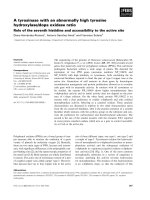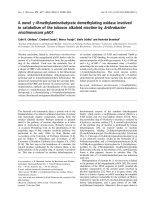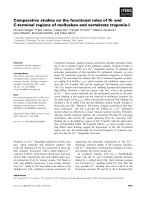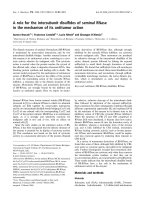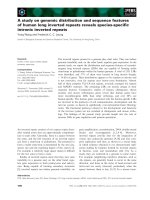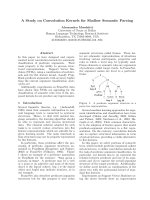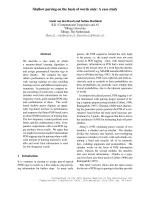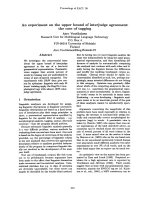Báo cáo khoa học: "A CONSIDERATION ON THE CONCEPTS STRUCTURE AND LANGUAGE IN RELATION TO SELECTIONS OF TRANSLATION EQUIVALENTS OF VERBS IN MACHINE TRANSLATION SYSTEMS" doc
Bạn đang xem bản rút gọn của tài liệu. Xem và tải ngay bản đầy đủ của tài liệu tại đây (203.42 KB, 3 trang )
A CONSIDERATION ON THE CONCEPTS STRUCTURE AND LANGUAGE
IN RELATION TO SELECTIONS OF TRANSLATION EQUIVALENTS OF VERBS IN MACHINE TRANSLATION SYSTEMS
Sho Yoshida
Department of Electronics, Kyushu University 36,
Fukuoka 812, Japan
ABSTRACT
To give appropriate translation equivalents
for target words is one of the most fundamental
problems in machine translation systrms.
Especially, when the MT systems handle languages
that have completely different structures like
Japanese and European languages as source and
target languages. In this report, we discuss
about the data strucutre that enables appropriate
selections of translation equivalents for verbs
in the target language. This structure is based
on the concepts strucutre with associated infor-
mation relating source and target languages.
Discussion have been made from the standpoint of
realizability of the structure (e.g. from the
standpoint of easiness of data collection and
arrangement, easiness of realization and compact-
ness of the size of storage space).
i. Selection of Translation Equivalent
Selection of translation equivalent of a
verb becomes necessary when,
(1) the verb has multiple meanings, or
(2) the meaning of the verb is modified under
different contexts (though it cannot be
thought as multiple meanigns).
For example, those words '?~ ', '~9~;~ ',
'~< ', '~',
' r~
', '@~< ',
are selectively used as translation equivalents of
an English verb 'play' according as its context.
i. play tennis : ~ ~r~
2. play in the ground : ~ ~ ~ ~"C~
3. The children were playing ball (with each
other) : -~/~,' ~rI~'g~t
~. play piano : ~'T~r~(
5. Lightning palyed across the sky as the storm
began : ~:~ ~f~h
In the above examples, they are not essential-
ly due to multiple meanigns of 'play' but need to
assign different translation euqivalents according
as the differences of contexts in the case of 1.
to 3., and due to multiple meanings in the cases of
4. orS.
A typical idea for selecting translation
euqivalents so far is shown in the following
example.
Lets take a verb 'play'. If the object
words of the verb belong to a category C play: ~ ~
obj
we give a verb '?~ '(=do) as its appropriate
translation equivalent. If the object words
belong to a category CI~ : ~< , we give '~< '
as an appropriate translation equivalent of
'play'.
Thus, we categories words (in the target
language) that are agent, object, " of a given
verb (in the source language) according as
differences of its appropriate translation
equivalents.
In other words, these words are categorized
according as "such expression as a verb with its
case filled with these words be afforded in the
target language or not", and are by no means
categorized by their concepts (meaning) alone.
For example, for tennis, baseball, E
CPobl~: S~ =(tennis, baseball, card, }, trans-
lation of 'play' are given as follows.
play tennis : T x~clt
play baseball : ~ci~
play card : ~ F~c?"
To the words belonging to C play: 9~ ( =
obJ
{piano, violine, harp, ), the translation
equivalent of 'play' is given as follows.
play piano : ~'TJ ~z~<
play violine : ~4 ~ i) ~r~
pla~ harp : ~" / ~r ~ <
Categories given in this way have a problem
that not a small part of them do not coincide
with natural categories of concepts. For example,
members ' 7 ~ (ten/lid) ' and ' ~(baseball) ' of a
category belong to a natural category
of concepts ~(ball game), but ' ~ Y(card)'
does'nt. Instead it belorEs to a conceptual
category ~ (game in general). ~ is considered
as a sub-category of ~ . Therefore, if we
regard C play: ~ ~
obJ as ~ , then ~ ~ (tennis),
~ ~" (card), 7 ~ ~ ~' ~ (football), ~7 (golf),
can be members of it, but ~(go), ~;~(shogi)
which also belong to the conceptual category ~,
are not appropriate as members of ~obl~ : $ ~
('pl%y go : ~r~', 'play shogi : ~}~%~&' are
not appropriate, instead we say 'pla~ go : ~r_~u
_~ ', 'play shogi : ~_~._~')
Therefore, cPla. y: $~ should be derided
OD~ play" ~ & _~lay. ~
into two categories Cob j " and tobJ "
@
The problem here is that, such division of
categories do not necessarily coincide with
natural division of conceptual categories. For
167
example, translation equivalent '~'' cannot be
assigned to a verb 'play' when object word of it
is ~ ~ ~ (chess), which is a game similar to ~ or
~. Moreover, if the verb differs from 'play',
then the corresponding structure of categories of
nouns also differs from that of play. Thus we
have to prepare different structure of categories
for each verb.
This is by no means preferable from both
considerations of space size and realizability on
actual data, because we have to check all the
combinations of several ten thousands nouns with
each verb.
2. Concepts Structure with. Associated Information
So we turn our standpoint and take natural
categories of nouns (concepts) as a base and
associate to it through case relation pairs of a
verb and its translation equivalent.
Let a structure of natural categories of
nouns were given (independently of verbs).
A part of the categories (concepts) structure
and associated information (such as a verb and
its translation equivalent pair through case
relation etc.) is given in Fig.1.
In Fig.l, verbs associated are limited to a
few ones such as Do (obJ = musical instrument)~
Pla~ (obJ = musical instrument). Becsuse, from
the definition of musical instrument :'an object
which is played to give musical sound (such as a
piano, a horn, etc.)", we can easily recall a
verb 'play' as the most closely related verb in
this ease.
It can generally be said that the more the
noun's relation to human becomes closer and the
more the level of abstract of the noun becomes
lower the numbers of verbs that are closely related
to them ~id therefore have to associate to them
(nouns) become large. And that the numbers of
associated ideoms or ideom like parases become
large, Therefore, the division of categories
must further be done.
The process of constructing this data
structure is as follows.
(1) Find a pair of verb and associated transla-
tion equivalent (Do, Play : ~9-& ) that can
be associated in common to a part of the
structure of the categories as in Fig.l, and
then find appropriate translation equivalents in
detail at the lower level categories.
(2) To each verb found in the process of the
association, consults ordinary dictionary of
translation equivalents and word usage of verbs
and obtain the set of all the translation
euqivalents for the verb.
(3) Then find nouns (categories) related through
case relation to each translation equivalent
verb thus obtained by consulting word usage
dictionary. Then check all the nouns belonging
to nearby categories in the given concepts
structure and find a nouns group to which we
associate the translation equivalent.
In this manner, we can find pairs of verb and
its translation equivalent for any noun belonging
to a given category. To summarize the advantage
of the ls~ter method, (1) to (4) follows.
(i) The only one natural conceptural categories
structure should be given as the basis of this
data structure. This categories structure is
stable, and will not be changed basically, and
is constructed independently from verbs. In
other words, it is constructed indepndently
from target language expression.
(2) To each noun in a given conceptual category,
,numbers of associated pairs of verb and its
translation equivalent are generally small and
can easily be found.
(3) Association of the pair of verb and its trans-
lation equivalent through case relation should
be given to one category for which the associa-
tion hold in common for any member of it. In
cplay : ~ <
Fig.l, a conceptual category -obJ is
created from two categories ~ (keyboad
musical instrument) and~ (string musical
instrument) for this purpose. And then
associate through case relation specific pair
of verb and its translation equivalent to
exceptional nouns in the category.
(4) From (i) to (3), it follows that this data
structure needs considerably less space and
is more practical to construct than the former
method.(chapter i)
3. Concludin5 Remarks
We proposed a data structure based on con-
cepts structure with associated pairs of verb and
its translation equivalent through case relations
to enable the appropriate selections of transla-
tion equivalents of verbs in MT systems.
Additional information that should be
associated to this data structure for the selec-
tions of translation equivalents is ideoms or
ideom like phrases. The association process is
similar to the association process in chapter 2.
0nly the selections of translation equiva-
lents for English into Japanese MT have been
discussed on the ass~nmption that the translation
equivalents for nouns were given.
Though the selection of translation equiva-
lents for nouns are also important, the effect
of application domain depeadence is so great
that we strongly relied on that property at the
present circumstances.
There are cases that translation equivalents
are determined by pairs of verbs and nouns to
each other. So we need to study the problem of
selection of translation equivalent also from
this point of view.
Reference
(i) Sho Yoshida : Conceptual Taxonomy for Natural
Language Processing, Computer Science &
Technologies, Japan Annual Reviews in Electro-
nics, Computers & Telecommunications, CH~HA
& North-Hollg_ud, 1982.
168
/
~ ~ ( :Keyboard instrument)
~ ~'T/ (:Piano)
~~ ~u~ y( : Organ)
/ /C obj Play:. < i
~~(:String instrument)
O (:Things) ~ (:Musical instrument)
~ ~obj Do.Play: ~~ ~ -'<4~1) ~(:vi°line)
J~D~° (@ W: n; : i~s<t r ume n t) Conc
7~u F (:Flute) inlnglish
~t ~,'m ( : Oboe ) ~/
C°ncept''''''''-! ~ (:Percussion inst~ume~t)
Case ,obtDo ~Play:~/O~ Translation (Japanese)
~ ~- ~
equivalent
Associated verb~" F'~ (:Drum)
l
/
Appropriate associated verb ~
Fig. 1
A Part of Concepts Structure with
Associated Information
169

